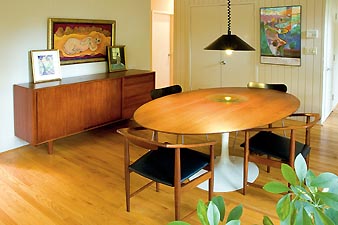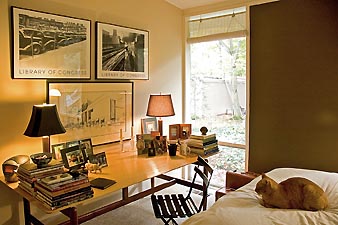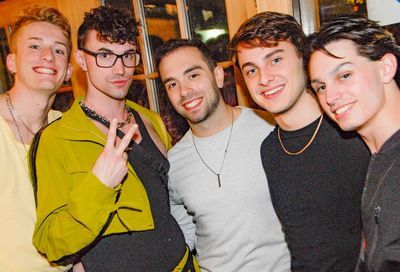Environs
Ray and Paul's mid-century modern home in Alexandria, VA
 |
MODERN LIVING in Alexandria, where the clean lines of modernism create a distinct space among the more traditional enclaves. Open spaces, wooded views and fabulous furniture choices make this 4BR, 2BA home a non-traditional showcase.
|
 |
Nearly six years ago, architect Ray Goodrow and high-school teacher Paul Newhouse left their traditional D.C. townhouse in Northwest for Hollin Hills, a Charles Goodman designed oasis of mid-century modernism amid the typical conservative red brick Georgians of Alexandria. The 21-year couple loves the modern design theme, with the requisite personal touches.
RAY: I lived in D.C. for 25 years. We just reached a point where we wanted a little more space. We had never seen this neighborhood before we started looking. The wooded nature of the landscape was attractive — after living in a pretty small townhouse with a little postage stamp yard, the feeling of openness really appealed to us. The house was empty when we first came upon it. I came out here many times and just looked from one end of the house to the other: From inside you could see the trees on both sides through the glass. That was really cool. There was just a feeling of openness.
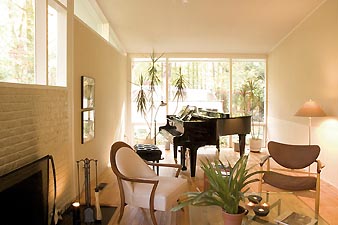
|
PAUL: We’ve never put anything on the front windows. A lot of people have blinds or draperies or something on all their windows but we enjoy just looking out. If we need privacy we go into the bedrooms. But with all the trees and plants, you feel kind of protected.
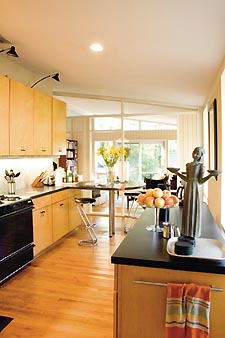 |
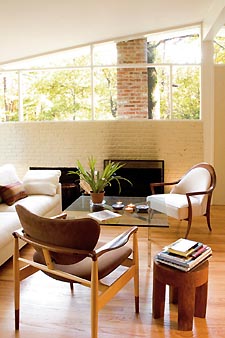 |
RAY: We used to go camping a lot. When we came out here we said, ”This is like walking around a campground.” You’re really more aware of the trees than the houses. That’s what they wanted when they developed it, and that’s what attracted us to it.
When we came out here, most of the stuff we had just didn’t work. We had a couple of things that obviously we’re never going to get rid of, mainly Paul’s piano. So every house we looked at we’d say, ”Where’s the piano gonna go?” We have a couple of other pieces, family things that you can’t seem to get rid of, so you try to make them work. We really kind of changed our style, but it wasn’t a wholesale change because we both had a tendency to towards a simple, clean look. Most everything here is new. It took a couple of years. (In the dining room) The table is an Eero Saarinen base with an oval teak top by Knoll. We were told that it came out of a conference room in New York. We got the sideboard on Ebay — it’s a standard Danish piece.
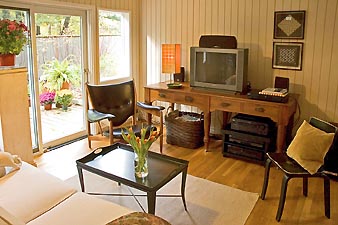
|
PAUL: It was the first thing we ever bought on Ebay. The seller was local, so we were able to go get it and save the shipping.
RAY: Chairs are hard to find. These are called ”Seven,” by Arne Jacobsen, a 1950s Danish designer. Eventually I want six of these, but we just don’t have them yet.
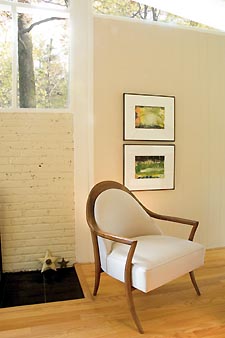 |
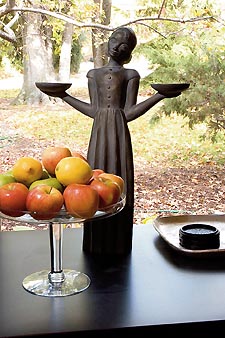 |
PAUL: (In the living room) We rented a couch and a chair while we were trying to figure out what kind of sofa we wanted. It was a gradual process.
RAY: A designer friend of ours tracked down these two chairs, plus another chair [in the den] and a desk [for the master bedroom] at a Baker outlet down in Florida. They were all designed in the ’50s by Finn Juhl. It’s kind of sad actually. The only time they’ve been into making modern furniture was in the ’50s and the early ’60s and then it stopped. There’s practically no modern furniture manufactured anymore in the United States. But Baker decided to reissue these Finn Juhl pieces the ’90s, before people started to get back into modern furniture. I think they made them for only about four or five years. We were lucky to get them.
I love this Robjohn-Gibbings chair, a ’50s take on a much older French chair, because it’s what this room is about: the contrast with the Finn Juhl chair, the contrast of the oval table with the modern Italian couch. The house is very rigid, so you try to break that up with the furniture.
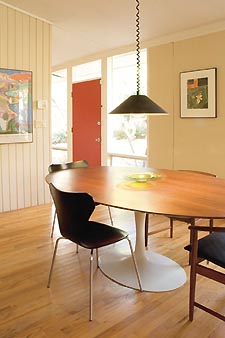 |
(In the TV room/den) This piece came with us from D.C. It’s not modern but I kind of rescued it from a building that was going to be demolished. Even though it was big for our house in Washington, I stuck it in the back of my truck. I just couldn’t see letting it get trashed. The top is walnut and the drawers are walnut so I couldn’t see getting rid of it. This is the other Finn Juhl chair I mentioned — the Chieftain’s Chair. Obviously, there are a lot of people who don’t find that it appeals to them — it’s a very unique thing. It works in this house, but it may not work everywhere.
We tried to personalize [the house], even though it’s a modern house. There’s stuff in every room that’s just odd, personal stuff. Paul’s mother did the quilt squares.
PAUL: Those are 5 to 10 years old. She’s still very active in quilting, that’s her retirement hobby.
RAY: (In the master bedroom) Here is the last Finn Juhl piece. It was designed to be used either as a dining table or a desk. You have the two woods, a maple top with walnut legs and stretcher. When I bought those other pieces we really didn’t have anyplace to put the desk, but I had to get it.
The bed is a very simple bed. My dad made it when I was a little kid. He also made these lamps back in the ’50s. It’s this stuff that you have a hard time getting rid of.
Support Metro Weekly’s Journalism
These are challenging times for news organizations. And yet it’s crucial we stay active and provide vital resources and information to both our local readers and the world. So won’t you please take a moment and consider supporting Metro Weekly with a membership? For as little as $5 a month, you can help ensure Metro Weekly magazine and MetroWeekly.com remain free, viable resources as we provide the best, most diverse, culturally-resonant LGBTQ coverage in both the D.C. region and around the world. Memberships come with exclusive perks and discounts, your own personal digital delivery of each week’s magazine (and an archive), access to our Member's Lounge when it launches this fall, and exclusive members-only items like Metro Weekly Membership Mugs and Tote Bags! Check out all our membership levels here and please join us today!

